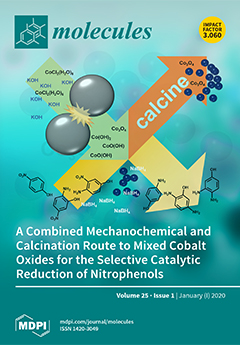Novel (4-methoxy or 4,8-dimethoxy)-3-methyl-
N-(6-oxo-2-thioxo-1,2,3, 6-tetrahydro- pyrimidin-4-yl) benzo [1,2-b: 5, 4-b’] difuran-2-carboxamide (
5a–
b) has been synthesized by the reaction of visnagenone–ethylacetate (
2a) or khellinone–ethylacetate (
2b) with 6-aminothiouracil in dimethylformamide or refluxing of benzofuran-oxy-
N
[...] Read more.
Novel (4-methoxy or 4,8-dimethoxy)-3-methyl-
N-(6-oxo-2-thioxo-1,2,3, 6-tetrahydro- pyrimidin-4-yl) benzo [1,2-b: 5, 4-b’] difuran-2-carboxamide (
5a–
b) has been synthesized by the reaction of visnagenone–ethylacetate (
2a) or khellinone–ethylacetate (
2b) with 6-aminothiouracil in dimethylformamide or refluxing of benzofuran-oxy-
N-(2-thioxopyrimidine) acetamide (
4a–
b) in sodium ethoxide to give the same products (
5a,
b) in good yields. Thus, compounds
5a–
b are used as an initiative to prepare many new heterocyclic compounds such as 2-(4-(3-methylbenzodifuran- 2-carbox-amido) pyrimidine) acetic acid (
6a–
b),
N-(thiazolo[3, 2-a]pyrimidine)-3-methylbenzo- difuran-2-carboxamide (
7a–
b),
N-(2-thioxopyrimidine)-methylbenzodifuran-2-carbimidoylchloride (8a–b), N-(2-(methyl-thio) pyrimidine)-3-methylbenzodifuran-2-carbimidoylchloride (9a–b), N-(2, 6 -di(piperazine or morpholine)pyrimidine)-1-(3-methylbenzodifuran)-1-(piperazine or morpholine) methanimine(10a–d), 8-(methylbenzodifuran)-thiazolopyrimido[1,6-a][1,3,5]triazine-3,5-dione (11a –b), 8-(3-methyl benzodifuran)-thiazolopyrimido[6,1-d][1,3,5]oxadiazepine-trione (12a–b), and 2,10 -di(sub-benzylidene)-8-(3-methylbenzodifuran)-thiazolopyrimido[6,1-d][1,3,5]oxadiazepine-3,5,11- trione (13a–f). All new chemical structures were illustrated on the basis of elemental and spectral analysis (IR, NMR, and MS). The new compounds were screened as cyclooxygenase-1/ cyclooxygenase-2 (COX-1/COX-2) inhibitors and had analgesic and anti-inflammatory activities. The compounds
10a–
d and
13a–
f had the highest inhibitory activity on COX-2 selectivity, with indices of 99–90, analgesic activity of 51–42% protection, and anti-inflammatory activity of 68%–59%. The inhibition of edema for the same compounds,
10a–
d and
13a–
f, was compared with sodium diclofenac as a standard drug.
Full article


